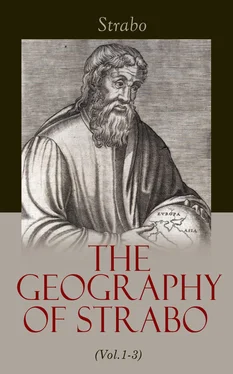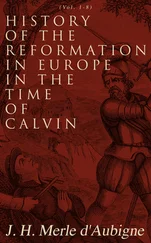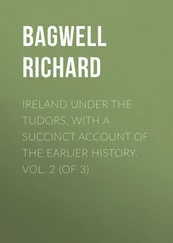Strabo - The Geography of Strabo (Vol.1-3)
Здесь есть возможность читать онлайн «Strabo - The Geography of Strabo (Vol.1-3)» — ознакомительный отрывок электронной книги совершенно бесплатно, а после прочтения отрывка купить полную версию. В некоторых случаях можно слушать аудио, скачать через торрент в формате fb2 и присутствует краткое содержание. Жанр: unrecognised, на английском языке. Описание произведения, (предисловие) а так же отзывы посетителей доступны на портале библиотеки ЛибКат.
- Название:The Geography of Strabo (Vol.1-3)
- Автор:
- Жанр:
- Год:неизвестен
- ISBN:нет данных
- Рейтинг книги:3 / 5. Голосов: 1
-
Избранное:Добавить в избранное
- Отзывы:
-
Ваша оценка:
- 60
- 1
- 2
- 3
- 4
- 5
The Geography of Strabo (Vol.1-3): краткое содержание, описание и аннотация
Предлагаем к чтению аннотацию, описание, краткое содержание или предисловие (зависит от того, что написал сам автор книги «The Geography of Strabo (Vol.1-3)»). Если вы не нашли необходимую информацию о книге — напишите в комментариях, мы постараемся отыскать её.
The Geography of Strabo (Vol.1-3) — читать онлайн ознакомительный отрывок
Ниже представлен текст книги, разбитый по страницам. Система сохранения места последней прочитанной страницы, позволяет с удобством читать онлайн бесплатно книгу «The Geography of Strabo (Vol.1-3)», без необходимости каждый раз заново искать на чём Вы остановились. Поставьте закладку, и сможете в любой момент перейти на страницу, на которой закончили чтение.
Интервал:
Закладка:
7. Cyrnus is called by the Romans Corsica; it is poorly inhabited, being both rugged and in many parts entirely inaccessible, so that the mountaineers, who live by plunder, are more savage than wild beasts. Whenever any Roman general invades the country, and, penetrating into the wilds, seizes a vast number of slaves, it is a marvel to behold in Rome how savage and bestial they appear. For they either scorn to live, or if they do live, aggravate their purchasers by their apathy and insensibility, causing them to regret the purchase-money, however small. 1721We must remark, however, that some districts are habitable, and that there are some small cities, for instance Blesino, Charax, Eniconiæ, and Vapanes. 1722The chorographer 1723says that the length of this island is 160 miles, its breadth 70; that the length of Sardinia is 220, and its breadth 98. According to others, the perimeter of Cyrnus is said to be about 1200 1724stadia, and of Sardinia 4000. A great portion of this latter is rugged and untranquil; another large portion is fertile in every production, but particularly in wheat. There are many cities, some are considerable, as Caralis 1725and Sulchi. 1726There is however an evil, which must be set against the fertility of these places; for during the summer the island is unhealthy, more particularly so in the most fertile districts; in addition to this, it is often ravaged by the mountaineers, whom they call Diagesbes, 1727who formerly were named Iolaënses. For it is said that Iolaus 1728brought hither certain of the children of Hercules, and established himself amongst the barbarian possessors [Pg 334] [CAS. 225] of the island, who were Tyrrhenians. Afterwards the Phœnicians of Carthage became masters of the island, and, assisted by the inhabitants, carried on war against the Romans; but after the subversion of the Carthaginians, the Romans became masters of the whole. There are four nations of mountaineers, the Parati, Sossinati, Balari, and the Aconites. These people dwell in caverns. Although they have some arable land, they neglect its cultivation, preferring rather to plunder what they find cultivated by others, whether on the island or on the continent, where they make descents, especially upon the Pisatæ. The prefects sent [into Sardinia] sometimes resist them, but at other times leave them alone, since it would cost too dear to maintain an army always on foot in an unhealthy place: they have, however, recourse to the arts of stratagem, and taking advantage of the custom of the barbarians, who always hold a great festival for several days after returning from a plundering expedition, they then fall upon them, and capture many. There are rams here which, instead of wool, have hair resembling that of a goat; they are called musmones, and the inhabitants make corselets of their hides. They likewise arm themselves with a pelta and a small sword.
8. Along the whole coast between Poplonium and Pisa these islands are clearly visible; they are oblong, and all three nearly parallel, 1729running towards the south and Libya. Æthalia is by far smaller than either of the other two. The chorographer says that the shortest passage from Libya to Sardinia is 300 1730miles. After Poplonium is the city of Cossæ, situated at a short distance from the sea: there is at the head of the bay a high hill upon which it is built; below it lies the port of Hercules, 1731and near to it a marsh formed by the sea. 1732At the summit of the cape which commands the gulf is a look-out for thunnies; for the thunny pursues his course along the coast, from the Atlantic Ocean as far as Sicily, in search not only of acorns, but also of the fish which furnishes the purple dye. As one sails along the coast from Cossæ to Ostia there are the towns of Gravisci, 1733Pyrgi, 1734Alsium, 1735and Fregena. 1736[From Cossæ] to Gravisci is a distance of 300 stadia, and between them is the place named Regis-Villa. This is said to have been the royal residence of Maleos the Pelasgian; they report that after he had reigned here for some time, he departed with his Pelasgians to Athens. These were of the same tribe as those who occupied Agylla. From Gravisci to Pyrgi is a little less than 180 stadia, and the sea-port town of the Cæretani is 30 stadia farther. [Pyrgi] contains a temple of Ilethyia 1737founded by the Pelasgi, and which was formerly rich, but it was plundered by Dionysius the tyrant of the Sicilians, at the time 1738of his voyage to Cyrnus. 1739From Pyrgi to Ostia is 260 stadia; between the two are Alsium and Fregena. Such is our account of the coast of Tyrrhenia.
9. In the interior of the country, besides the cities already mentioned, there are Arretium, 1740Perusia, 1741Volsinii, 1742Sutrium; 1743and in addition to these are numerous small cities, as Blera, 1744Ferentinum, 1745Falerium, 1746Faliscum, 1747Nepita, 1748Statonia, 1749and many others; some of which exist in their original state, others have been colonized by the Romans, or partially ruined by them in their wars, viz. those they frequently waged against the Veii 1750and the Fidenæ. 1751Some say that the inhabitants of Falerium are not Tyrrhenians, but Falisci, a distinct nation; others state further, that the Falisci speak a language peculiar to themselves; some again would make it Æquum-Faliscum on [Pg 336] [CAS. 226] the Via Flaminia, lying between Ocricli 1752and Rome. Below Mount Soracte 1753is the city of Feronia, having the same name as a certain goddess of the country, highly reverenced by the surrounding people: here is her temple, in which a remarkable ceremony is performed, for those possessed by the divinity pass over a large bed of burning coal and ashes barefoot, unhurt. A great concourse of people assemble to assist at the festival, which is celebrated yearly, and to see the said spectacle. Arretium, 1754near the mountains, is the most inland city: it is distant from Rome 1200 stadia: from Clusium 1755[to Rome] is 800 stadia. Near to these [two cities] is Perusia. 1756The large and numerous lakes add to the fertility of this country, 1757they are navigable, and stocked with fish and aquatic birds. Large quantities of typha, 1758papyrus, and anthela 1759are transported to Rome, up the rivers which flow from these lakes to the Tiber. Among these are the lake Ciminius, 1760and those near the Volsinii, 1761and Clusium, 1762and Sabatus, 1763which is nearest to Rome and the sea, and the farthest Trasumennus, 1764near Arretium. Along this is the pass by which armies can proceed from [Cisalpine] Keltica into Tyrrhenia; this is the one followed by Hannibal. There are two; the other leads towards Ariminum across Ombrica, and is preferable as the mountains are considerably lower; however, as this was carefully guarded, Hannibal was compelled to take the more difficult, which he succeeded in forcing after having vanquished Flaminius in a decisive engagement. There are likewise in Tyrrhenia numerous hot springs, which on account of their proximity to Rome, are not less frequented than those of Baiæ, which are the most famous of all.
10. Ombrica lies along the eastern boundary of Tyrrhenia, and commencing from the Apennines, or rather beyond those mountains, [extends] as far as the Adriatic. For commencing from Ravenna, the Ombrici inhabit the neighbouring country together with the cities of Sarsina, Ariminum, 1765Sena, 1766†and Marinum.† 1767To their country likewise belongs the river Esino, 1768Mount Cingulum, [the city of] Sentinum, 1769the river Metaurus, and the Fanum Fortunæ; 1770for about these parts are the boundaries which separate ancient Italy and [Cisalpine] Keltica on the side next the Adriatic, although the boundary has frequently been changed by the chief men of the state. First they made the Esino the boundary; afterwards the river Rubicon: the Esino being between Ancona and Sena, and the Rubicon between Ariminum and Ravenna, both of them falling into the Adriatic. At the present day, however, since Italy comprehends the whole country as far as the Alps, we need take no further notice of these limits. All allow that Ombrica 1771extends as far as Ravenna, as the inhabitants are Ombrici. From Ravenna to Ariminum they say is about 300 stadia. Going from Ariminum to Rome by the Via Flaminia, the whole journey lies through Ombrica as far as the city of Ocricli 1772and the Tiber, a distance of 1350 stadia. This, consequently, is the length [of Ombrica]; its breadth varies. The cities of considerable magnitude situated on this side the Apennines along the Via Flaminia, are Ocricli on the Tiber, Laroloni, 1773and Narnia, 1774through which the Nera 1775flows. This river discharges itself into the Tiber a little above Ocricli; it is not navigable for large vessels. After these are Carsuli and Mevania, 1776past which latter the Teneas 1777flows, by which river the merchandise of the plain is transported in small vessels to the Tiber. There are also other cities well populated, rather on account of the route along which they lie, than for their political importance. Such are Forum Flaminium, 1778Nuceria 1779where wooden vases are manufactured, and Forum Sempronium. 1780Going from Ocricli to Ariminum, on the right of the [Pg 338] [CAS. 228] way are Interamna, 1781Spoletium, 1782Asisium, 1783and Camerta, situated in the mountains which bound Picenum. On the other side 1784are Ameria, 1785Tuder, 1786a well-fortified city, Hispellum, 1787and Iguvium, 1788near to the passes of the mountain. The whole of this country is fertile, but rather too mountainous, and producing more rye 1789than wheat for the food of the inhabitants. The next district, Sabina, is mountainous, and borders on Tyrrhenia in like manner. The parts of Latium which border on these districts and the Apennines are very rugged. These two nations 1790commence from the Tiber and Tyrrhenia, and extend as far as the Apennines which advance obliquely towards the Adriatic: Ombrica extends, as we have said, beyond as far as the sea. We have now sufficiently described the Ombrici.
Читать дальшеИнтервал:
Закладка:
Похожие книги на «The Geography of Strabo (Vol.1-3)»
Представляем Вашему вниманию похожие книги на «The Geography of Strabo (Vol.1-3)» списком для выбора. Мы отобрали схожую по названию и смыслу литературу в надежде предоставить читателям больше вариантов отыскать новые, интересные, ещё непрочитанные произведения.
Обсуждение, отзывы о книге «The Geography of Strabo (Vol.1-3)» и просто собственные мнения читателей. Оставьте ваши комментарии, напишите, что Вы думаете о произведении, его смысле или главных героях. Укажите что конкретно понравилось, а что нет, и почему Вы так считаете.












![Anne Blunt - A Pilgrimage to Nejd, the Cradle of the Arab Race. Vol. 2 [of 2]](/books/750183/anne-blunt-a-pilgrimage-to-nejd-the-cradle-of-the-thumb.webp)